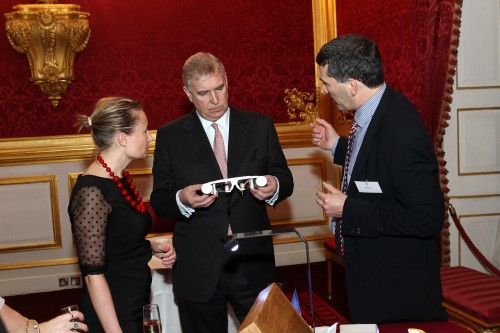
Seeing the future: HRH The Duke of York at the UK launch of the International Year of Light at St James’s Palace. (Courtesy: Paul Burns)
By Matin Durrani
And so last night to St James’s Palace in London and the official UK launch of the International Year of Light and Light-based Technologies (IYL 2015). The building, which belongs to the British monarchy and has a long history as a royal residence, might sound a rather grand venue for the event – but when HRH The Duke of York is the patron for IYL 2015 in the UK, then who wouldn’t take up his invitation to host the opening reception for the year?
The evening began with a short speech from the Duke of York, who said that he had always had an interest in physics despite not having taken it as a single subject at school – and that he was “right behind” all the activities taking place in the IYL 2015. “The International Year of Light is about how we have used light over the centuries,” he told the 200 or so guests. “It is how we are applying light, photonics and various other aspects in order to make the world a better place, not only for ourselves, but for future generations.”
After comments from UK science minister Greg Clark, we then heard from Kat Harrison of the charity SolarAid, whose goal is to get rid of the kerosene lamp in Africa by 2020. As she explained, such lamps are inefficient, dangerous and polluting – and the charity is keen to encourage the use instead of portable solar lights, some of which were on display to light up several of the reception rooms at St James’s.
I also bumped into several familiar faces, including the current president of the European Physical Society John Dudley – one of the driving forces behind IYL 2015 and who wrote the introduction to our recent collection of 10 of the top articles from Physics World about light. I also had a chat with David Payne (photonics guru from the University of Southampton), Martin Hendry (from the University of Glasgow, who’s writing for the magazine’s upcoming March special issue about light) and Sir Peter Knight, former president of the Institute of Physics, which publishes Physics World.
If you’re wondering what the Duke of York is doing in the image above, well he’s trying on some holographic glasses developed by Simon Hall (pictured, right) and staff from the adaptive-optics group at the UK’s National Physical Laboratory. You can find out more about the glasses in a blog post written by my colleague Tushna Commissariat, who visited NPL last year. Basically, the device lets users overlay full-colour, 3D, high-definition images into their normal line of sight, thereby interacting with their surroundings.
One of the most innvotive, the most simple and probably the cheapest lighting systems has been the the “diffractive bottle” filled with a simple mixture-liquid. A few of them fixed in the holes in the roof and the walls,say, of a class room, illuminates it sufficiently for the work of the pupils and the students. This “bottle lamp” is spreading fast in some countries. It should be worthwhile during this IYL 2015, to look for its optimisation and spreading in different places.
It is 150 years since James Clerk Maxwell’s work on electromagnetism.
http://vixra.org/pdf/1303.0201v1.pdf
It’s an good interesting to heard it. It contains meaningful also connected with physical life. I’m far away from the venue . What a pity…